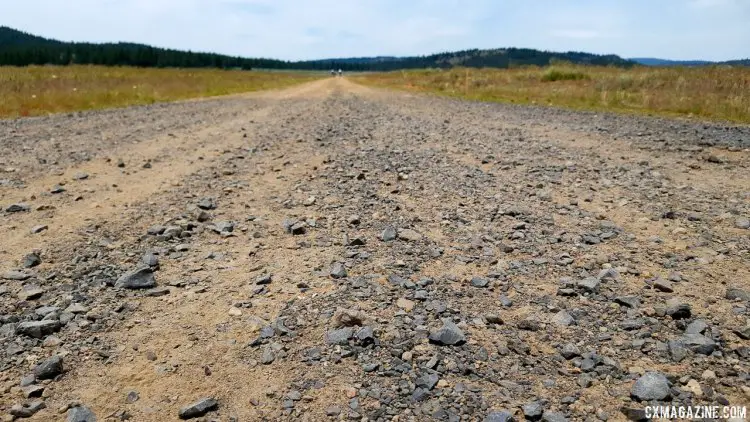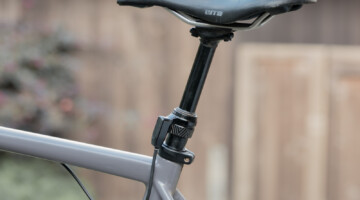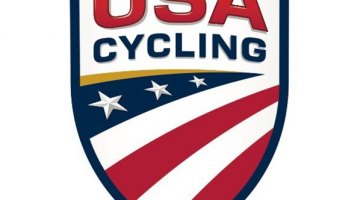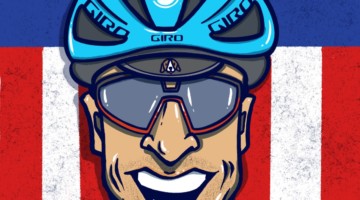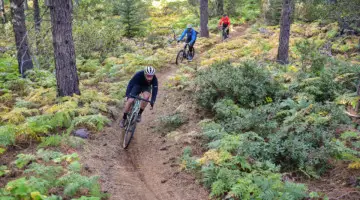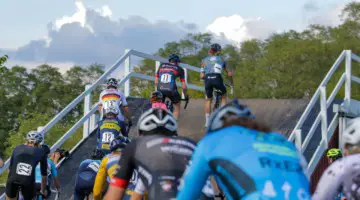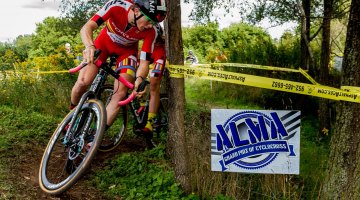"The gravel segment is the Wild West of bike racing..."
We facetiously attributed this quote to former USA Cycling CEO Steve Johnson in our report, “USA Cycling to Organize National Gravel Series, Regulate Gravel Racing and Bikes,” published on April 1, 2015. But hang around the start line before the pros take off to tackle the Lost and Found 100-mile gravel race, and you’ll believe that quote rings true.
Gravel racing, new only in terms of label, has soared in recent years in participation and equipment tailored to it. And every year it attracts more top pros from other bike racing disciplines. This year, cyclocross racers, mountain bike racers, road racers, desk engineers and professional triathletes headed to California’s Plumas County in the Sierra Nevada mountains, some motivated to win and perhaps wear the Lost Sierra Triple Crown, others motivated to sample the legendary gravel roads, breathtaking scenery and the many breathtaking (literally) climbs.
These contenders, with diverse backgrounds, prepared for this year’s Lost and Found gravel grinder with greatly varied approaches and equipment. Defending champ Tobin Ortenblad (Donkey Label) maintained much of his winning 2015 formula, winning both the Sea Otter cyclocross race and the Cat’s Hill Criterium for the second year in a row, but swapped out his double chainring Specialized Crux and WTB Nano 40c tires for a single ring Santa Cruz Stigmata and Clement MSO 36c tires.
First-time Lost and Found racers Carl Decker (Giant Factory Offroad) and Barry Wicks (Kona) packed on the miles and saddle time while bikepacking and exploring dirt roads riding between the San Francisco Bay Area and San Dimas to race the Bonelli Park Kenda Cup #4 mountain bike race. Riding 600 miles on forty pound bikes and then racing against some of the world’s best seemed like a good recipe to handle the 100 miles at altitude waiting for them at the Lost and Found.
But the two mountain bike racers took opposite approaches to equipment, with Decker simply adding his road pedals, a lower gear and his sponsor’s gravel tires to his Giant TCX cyclocross bike [See our profile of Carl Decker's gravel-oriented Giant TCX Advanced from Lost and Found here], while Wicks, the 2015 Grinduro winner (see our feature on Wicks and his winning bike in Issue 31), built up a monster cross machine adding an MRP Loop suspension fork, KS dropper post, XTR wheels and rear derailleur to his aluminum Private Jake bike. For tires, Wicks opted for the lightweight but undersized Maxxis 40c Rambler EXO tires. Would Decker’s lightweight and simple approach be an advantage, or would Wicks out-descend the field and have enough of a gap to outclimb the others despite the weight penalty of his fork and post?
[instagram_embedding url="https://www.instagram.com/p/BGMf0h4rDka/?taken-by=wicknasty" color="#FF3300" caption="false"]
While last year’s second place (and newly retired) Ben Berden didn’t make the trip, 2015 third place overall and amateur winner Matt Fox, a Tesla engineer, headed to this year’s event armed with the confidence that he had the potential to upset the favorites. Fox would eschew his amateur status in favor of avoiding the five-minute handicap he gave the top racers in 2015, and hoped by starting with with them this year, he could perhaps save energy by drafting off them, instead of chasing all but the top two down, as he did last year. Working in early morning rides before work, Fox collected Strava KOMs by the handful in his pre-race prep. And despite his modest steel Transition Bikes Rapture frame paired with a flat bar clearly reflecting his amateur status, his second-fastest (on Strava) final climb up Walker Mine in 2015 told him he belonged with the pros.
Meanwhile, Decker’s housemate, Matt Lieto (Trek), a professional triathlete, didn’t want Decker to have all the fun, and tagged along with his cantilever-equipped Trek Crockett to the event. Lieto, uncomfortable starting the long bike leg completely dry, was unsuccessful in convincing race organizers to reverse the start and send racers into the cold waters of Lake Davis.
Hoping to be this year’s Matt Fox was dark horse contender, Reno-based Justin Thomas (TCI Wealth Advisors), who was riding high on a string of mountain bike wins heading into this year’s race.
Former road National Champion Robin Farina (Panaracer / NoTubes) returned to the 2016 Lost and Found as the odds-on favorite for the women's race. The "retired" Nevada City-based racer has quickly built an impressive gravel racing resume, winning both the 2015 event and the 2015 Crusher in the Tushar. Despite trying a new prototype saddle and different tires than 2015, Farina took little risk in her attempt to finish 2016 with the same result. [See our profile of Robin Farina's Santa Cruz Stigmata here.]
Last year’s biggest threat to Farina, Helene Drumm, made the return trip, while Argentinian Caro Gomez Villafane, missed her first Lost and Found in three years.
With their own preparation done, racers packed their bags and rolled their version of two-wheel wagons to Lake Davis to take their shot at conquering the Wild West of the Lost and Found.
Experience Attracts, Separates
Most racers make the trip purely for the experience to enjoy seldom-traveled, challenging dirt roads, scenic vistas, well-stocked aid stations and friendly company with a dash of adventure.
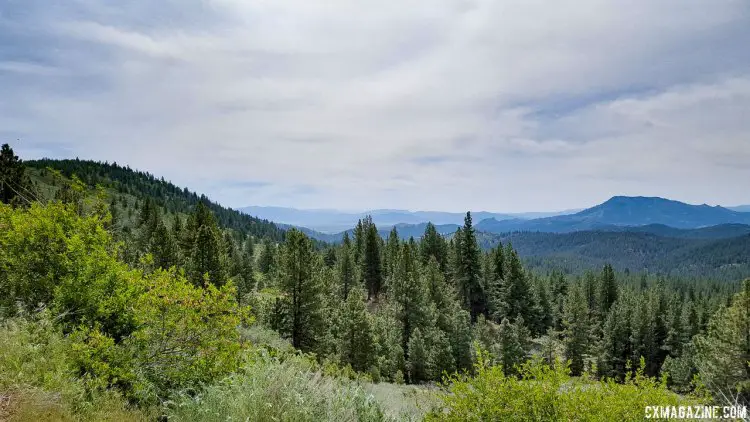
Come for the views, return for the challenge. 2016 Lost and Found Gravel Race. © Cyclocross Magazine
The top racers line up hoping to leverage their experience into a win. Experience can come in the form of miles, years, past participation or sometimes a mixture of the three. Regardless of the source, experience is invaluable in surviving and winning a long gravel race.
Watch the start of each wave of riders, starting with the first wave of pro 100-mile racers, followed by the amateur group, then followed by the 60-mile and 30-mile groups. Judging by starting speed alone, you’d probably guess the pros were the ones out for a leisurely 30-mile Saturday stroll.
[instagram_embedding url="https://www.instagram.com/p/BGPTHt9tTSU/?taken-by=cxmagazine" color="#FF3300"]
With temperatures expected to climb to near 90, and 7,000 feet of sunny climbs ahead, the experienced pros had little rush to accelerate the hurt. Six foot, four inch Wicks, sitting tall on his newly-assembled creation, led the field slowly away from the lake, looking every bit like the gravel peloton’s patron that Decker feared most, despite it being Wicks’ first attempt at the event. Having won the BC Bike Race several times, Wicks knows all about long days in the saddle.
Decker was content to roll slowly and follow Wicks—it was a position he was used to after the pair’s 600-mile bikepacking adventure. “That guy is super strong,” Decker told Cyclocross Magazine of his adventure with Wicks. “I’d take a two-minute pull and then he would pull for miles.”
“He's just a triathlete, don't worry about him” -Decker describing his housemate Lieto to his fellow racers
Lieto has plenty of racing experience, although most of his bike racing, even when on dirt, comes after swimming and before a run. But when the road points up, experience is of little help without an engine. Lieto revved up his engine on the pavement miles, and when the dirt road pointed up, he put bike racers on notice that he wasn’t planning to just tag along and follow wheels but blaze his own path. After 45 minutes of riding around with bike racers, Lieto was anxious to ride in his comfort zone: alone. He pushed the pace on the climb, shedding the group. “He's just a triathlete, don't worry about him,” Decker comforted fellow chasers, but the chasing group would shrink to ten by the pavement.
Meanwhile, Fox was just trying his best to tag along. After starting five minutes behind the pros in 2015, he rode at his own pace and leapfrogged riders the rest of the way. Riding shoulder-to-shoulder with the many of the racers he beat the previous year was a new experience this year, and a taxing one at that. Matching their pace, and the pace of world-class triathletes on the first 11.3 mile Smith Peak Climb, proved to be his undoing. In 2015, his slow-starting wheels warmed up in the middle flat miles of the race, besting Ortenblad’s times and setting a Strava record that still stands after this year’s race. However, after this year’s fast start, Fox wouldn’t have a chance to beat his own record, and would switch into survival mode, and finish 30 minutes slower than the previous year, in eighth place.
Maximizing Speed, or Maximizing Vision
For some of us, the main point of climbing is to descend, and maximum descending speed correlates to maximum fun. Many pro bike racers aren’t any different, and whether it’s the thrill of riding on the edge, the ego boost of dropping your competitors or knowing a few nights in the garage paid off in the form of a faster ride, it’s the high-speed downhills that are hardest on equipment and have the most potential to end a racer’s day.
https://www.instagram.com/p/BGQ0G4XNTRe/?taken-by=cxmagazine
While descending skill or descending equipment (fork, dropper post) can increase speeds, patience and vision ended up being more critical to win the 100-mile ride. Decker, sponsored by Schwalbe and racing the G-One 40c tubeless gavel tire, knew he was on relatively lightweight tires compared to his typical mountain bike treads, and knew the key to winning was avoiding mechanicals and deferring some amount of fun. The Downieville Classic All Mountain winner can out-descend almost anyone, but on the dusty, rock-filled roads of the Lost and Found, Decker placed a premium on seeing his lines and the fire road’s rocks, not following wheels. In the first half of the race, Decker was content to let gaps open on the descents, patiently waiting for the dust to clear, so that he could choose careful lines and avoid tire-slashing rocks. "My whole M.O. was protect the tires," Decker revealed. "I was letting people go on descents, and bridging back up. I was like, okay, don't ride in dust. I was spotting, since there are so many marbles to hit, and I was running high pressure and being super anal about my line selection."
It worked. One by one, competitors pulled over to repair tire problems, while Decker kept rolling. "You end up working more, but you end up in the long-run ahead of the game."
"My whole M.O. was protect the tires" -Decker
In the women’s race, Farina didn’t have the same luck as Decker, and just 10 miles into the ride, before the major climbing started, she suffered a slow leak. Riding it as long as she could, hoping the sealant would do its trick, Farina eventually had to fix her flat, and watched Drumm along with new competitors Julie Young and Olivia Dillon go by. "I was kind of upset, because I was like, I guess my day is over, but instead I had really good legs, and I decided I was going to chase and chase," Farina recalled. There were 90 miles left, Farina knew what lay ahead, and knew she had time and the legs to catch back up.
Tire issues played as big a role in the men’s race as legs and lungs. Wicks, armed with his 40mm travel fork and dropper post, suffered the same fate, and on the course’s rocky sections, flatted three times and suffered massive delays after changing out his whole tire at an aid station. Chris McGovern, one of the founding fathers of the Lost and Found, also suffered tire problems, and would throw in the towel, turning off at the 60-mile-ride cut-off. Ortenblad, riding narrower tires than he used in 2015, suffered a puncture as well, and although sealant prevented him from needing to add a tube or change a tire, on three separate times he had to add air or wait for the sealant to repair the cut. Ortenblad revealed after his ride that during those stressful moments, he wasn't "smart enough to figure out how to use my CO2 out there."
As Ortenblad fiddled with his tire, his chances of defending his Lost and Found title were disappearing down the road. A fellow racer passed him a frame pump, and eventually Ortenblad was back chasing, but the damage was done. After the race, he applauded Decker for holding back on the descents. "I could tell I would hit the descents a bit more aggressively than everybody, maybe [that wasn't] best idea. I could tell Carl was riding a bit more conservative, if he couldn't see the ground very well, he was just riding smarter."
"I could tell I would hit the descents a bit more aggressively than everybody, maybe [that wasn't] best idea." -Ortenblad
Finally, nearly sixty miles into the ride, Decker found himself at the front on a descent, and with clear vision, let it rip. He looked back, saw he opened up a bit of a gap over Ortenblad and the dwindling lead group, and settled in for a long solo ride.
Experience and clear vision were needed not only to avoid tire-destroying rocks, but also to navigate the course. Brightly colored ribbon flags marked the course, but after nearly four hours of riding, out on his own again, in time trial mode and blurry-eyed, Lieto came to a T intersection and had to make a quick decision. He turned left onto Ward Creek road. Decker had gone right. Ortenblad, Lance Haidet (Raleigh Clement) and Thomas went right. Lieto set off on a three-mile solo ride that ended his chances of catching his housemate, or landing on the podium.
Forty Miles of Survival
Gravel races rarely come down to a sprint, and the aerodynamic efficiencies of a 100-rider strong peloton as seen in road races are not a factor at the end of the race. Decker took off 40 miles from the finish, but his road racing experience instilled a paranoia that it was a suicide mission only to be ruined by “an advancing chase group.”
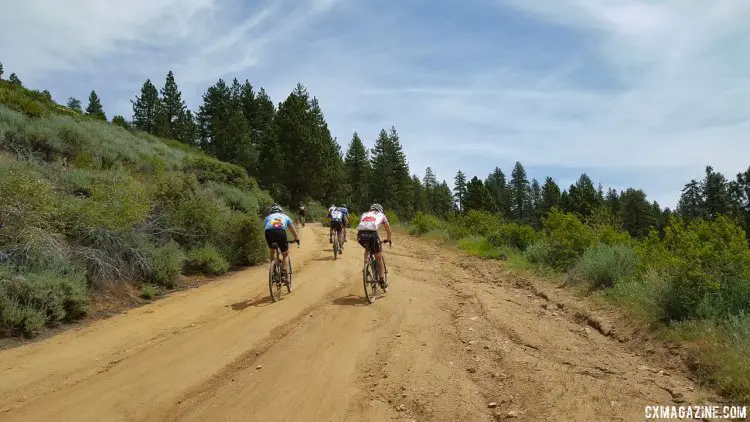
Long, hot, hilly dirt roads present physical and equipment challenges for 2016 Lost and Found Gravel Race attendees. © Cyclocross Magazine
An organized chase group never formed. Thomas rode steadily, with a silver medal in his sights. Haidet gave chase at a pace that was an impressive 15 minutes faster than his 2015 debut. Ortenblad was on a mission to pass back the riders who flew by as he fiddled with his tires. Lieto was in familiar territory, chasing riders with a head start and with nobody to draft off of, but was thrown off by the loose gravel, missing aerobars and distracting, nagging thoughts of what could have been.
Decker looked back, but there was nobody in sight. Was he lost?
"I was cramping up, coming apart, looking over my shoulder, and it was like a horror video." -Decker
Soon the pavement arrived, and the finish line was nearly in view. With plenty of time to celebrate, Decker crossed the line in 5:21, three minutes off Ortenblad’s 2015 record, but in hotter conditions.
Behind, Ortenblad picked off riders on the final climb, and passed Thomas on the final paved section to take second, 12 minutes in arrears. Thomas rolled in for third, while Lieto, chasing back from his detour, caught Haidet and outsprinted him for fourth.
"I dug really deep, and it hurt really deeply," Decker said, relieved that he wasn't caught after his long solo ride. "I was cramping up, coming apart, looking over my shoulder, and it was like a horror video."
"Yeah, I'm happy, I flatted a couple of times," Ortenblad reflected after his ride. "Regardless of flats, Carl [Decker] was riding really well, it would have been really hard to beat him."
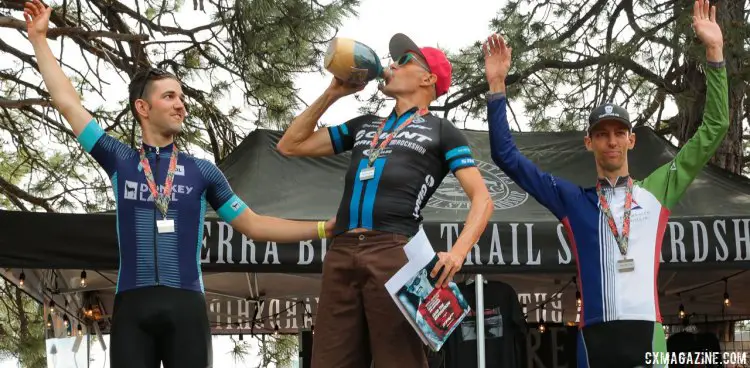
Decker celebrates his win with Ortenblad and Thomas. 2016 Lost and Found Gravel Race. © Cyclocross Magazine
Farina overcame her flat to catch the on-the-road women's leader, Julie Young, at mile 30. "I finally decided I was going to throw down," Farina told Cyclocross Magazine. "I got in a fast group of guys...and it's all really up to the last climb, which is brutal."
Farina would win the women’s race going away, and finished in 5:57, also just three minutes off her 2015 winning time despite fixing her flat. Farina’s time was good enough for ninth in the pro men, just behind Barry Wicks.
"Definitely not easier. This course is unforgiving." -Farina after her second win in as many attempts.
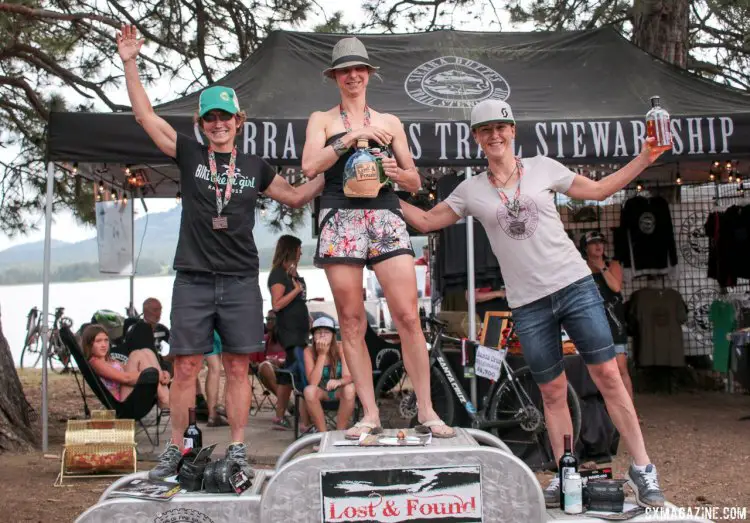
Robin Farina defended her title over Julie Young and Olivia Dillon. 2016 Lost and Found Gravel Race. © Cyclocross Magazine
After eyeing the event since it started, Decker was motivated to attend the Lost and Found this year by the Triple Crown offered up by the Sierra Buttes Trail Stewardship for the top overall racer competing in the Lost and Found, Downieville Classic and Grinduro. Decker and Farina are now leading the chase for the crown. Might we see Farina join Decker at Downieville in defending the lead? Stay tuned.
See our full photo and video gallery below the results.
2016 Lost and Found 100 Gravel Ride Results - Pro Women
| Overall | Name | Bib No | Time | Pace |
|---|---|---|---|---|
| 1 | Robin Farina | 674 | 05:57:42 | 3:35/M |
| 2 | Julie Young | 739 | 06:21:23 | 3:49/M |
| 3 | Olivia Dillon | 660 | 06:33:03 | 3:56/M |
| 4 | Sian Turner Crespo | 891 | 06:46:33 | 4:04/M |
| 5 | Caitlin Curran Bernstein | 618 | 06:58:25 | 4:11/M |
| 6 | Helene Drumm | 663 | 06:58:39 | 4:11/M |
| 7 | Emily Kachorek | 741 | 06:58:46 | 4:11/M |
| 8 | Campbell Steers | 869 | 07:16:36 | 4:22/M |
2016 Lost and Found 100 Gravel Ride Results - Pro Men
| Overall | Name | Bib No | Time | Pace |
|---|---|---|---|---|
| 1 | Carl Decker | 654 | 05:21:19 | 3:13/M |
| 2 | Tobin Ortenblad | 813 | 05:33:35 | 3:20/M |
| 3 | justin thomas | 945 | 05:34:00 | 3:20/M |
| 4 | Matt Lieto | 765 | 05:34:59 | 3:21/M |
| 5 | Lance Haidet | 738 | 05:35:00 | 3:21/M |
| 6 | Rob Evans | 673 | 05:38:32 | 3:23/M |
| 7 | Nate English | 671 | 05:53:11 | 3:32/M |
| 8 | Barry Wicks | 909 | 05:56:26 | 3:34/M |
| 9 | Scott Hooper | 713 | 06:03:11 | 3:38/M |
| 10 | Matthew Fox | 685 | 06:03:42 | 3:38/M |
| 11 | Cody Kaiser | 742 | 06:05:25 | 3:39/M |
| 12 | Vinny Owens | 814 | 06:10:45 | 3:43/M |
| 13 | Lucas Strain | 831 | 06:12:12 | 3:47/M |
| 14 | Zach Heath | 932 | 06:21:39 | 3:49/M |
| 15 | John Behrens | 613 | 06:25:59 | 3:52/M |
| 16 | Kurt Stockton | 871 | 06:25:59 | 3:52/M |
| 17 | Dain Zaffke | 603 | 06:26:58 | 3:52/M |
| 18 | Gareth Feldstein | 676 | 06:28:08 | 3:53/M |
| 19 | AJ Snovel | 933 | 06:33:02 | 3:56/M |
| 20 | Aren Timmel | 885 | 06:43:45 | 4:02/M |
| 21 | Benjamin Gomez Villafone | 929 | 06:45:05 | 4:03/M |
| 22 | michael larson | 756 | 06:46:31 | 4:04/M |
| 23 | Rich Staley | 865 | 06:46:36 | 4:04/M |
| 24 | William Youngman | 757 | 06:49:14 | 4:06/M |
| 25 | Jared Franzoia | 866 | 06:54:25 | 4:09/M |
| 26 | Scott Chapin | 641 | 07:01:49 | 4:13/M |
| 27 | jake orness | 812 | 07:06:06 | 4:16/M |
| 28 | Mitchell Trux | 890 | 07:14:18 | 4:21/M |
| 29 | Sandor Lengyel | 763 | 07:23:05 | 4:26/M |
| 30 | Dean Poshard | 825 | 07:31:46 | 4:31/M |
| 31 | Jordan Kestler | 748 | 07:35:58 | 4:34/M |
| 32 | nicholas haig-arack | 701 | 07:52:35 | 4:44/M |
| 33 | Peter Knudsen | 749 | 08:08:34 | 4:53/M |
| 34 | Nicholas Terzakis | 883 | 08:08:34 | 4:53/M |
| 35 | Zachary Cunningham | 651 | 08:08:34 | 4:53/M |
| 36 | Christopher Namba | 804 | 08:08:37 | 4:53/M |
2016 Lost and Found 100 Gravel Ride Results - Singlespeed
| Overall | Name | Bib No | Time | Pace |
|---|---|---|---|---|
| 1 | Corey Hansen | 948 | 06:08:55 | 3:45/M |
| 2 | Brendan Lehman | 761 | 06:21:35 | 3:49/M |
| 3 | clint claassen | 942 | 06:42:44 | 4:02/M |
| 4 | Dylan McReynolds | 790 | 07:05:07 | 4:15/M |
| 5 | Mark Fellows | 678 | 07:08:47 | 4:17/M |
| 6 | Justin Hintz | 708 | 07:22:28 | 4:29/M |
| 7 | max leonov | 937 | 07:24:12 | 4:30/M |
| 8 | Eric Nelson | 805 | 07:25:17 | 4:30/M |
| 9 | Clint Holtzen | 712 | 08:54:47 | 5:24/M |













